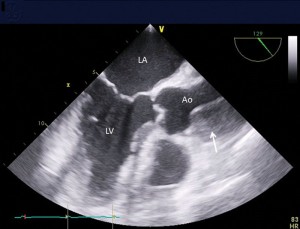Early diagnosis of retrograde type A aortic dissection after thoracoabdominal aneurysm repair
Archived series ("Inactive feed" status)
When?
This feed was archived on October 03, 2018 15:44 (
Why? Inactive feed status. Our servers were unable to retrieve a valid podcast feed for a sustained period.
What now? You might be able to find a more up-to-date version using the search function. This series will no longer be checked for updates. If you believe this to be in error, please check if the publisher's feed link below is valid and contact support to request the feed be restored or if you have any other concerns about this.
Manage episode 156290674 series 1183562

Routine postoperative TEE exam after aortic surgery is instrumental in the early diagnosis of multiple types of complications including retrograde type A aortic dissection. Shown is midesophageal aortic valve long-axis view showing intramural hematoma in the ascending aortic wall. Image source: A&A Case Reports
Also available on YouTube.
Type A aortic dissection immediately after open replacement of the thoracoabdominal aorta is a rare and potentially lethal complication that has only been reported twice previously. Dr. Abraham Sonny, Cardiothoracic Anesthesiology, Anesthesiology Institute, Cleveland Clinic, Cleveland, Ohio, and colleagues describe a 74-year-old man with a history of expanding Crawford Type I thoracoabdominal aortic aneurysm who presented for open surgical repair in their article published in the March 1 issue of A&A Case Reports titled “Retrograde Type A Aortic Dissection After Thoracoabdominal Aneurysm Repair: Early Diagnosis with Intraoperative Transesophageal Echocardiography.”
Routine intraoperative transesophageal echocardiography after the repair revealed a new type A aortic dissection extending up to the sinotubular junction. Subsequent emergent aortic arch repair was performed successfully under deep hypothermic circulatory arrest. Intraoperative type A aortic dissection is associated with a very high risk of early mortality and morbidity such as prolonged ventilation, renal failure, and cardiogenic shock. Routine postoperative transesophageal echocardiographic exam after aortic surgery facilitates early diagnosis and may identify associated complications such as pericardial effusion, aortic insufficiency, and coronary ischemia. Efficient surgical decision making and cerebral protection during the emergent repair are necessary for a successful outcome.
7 episodes




